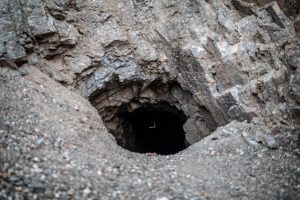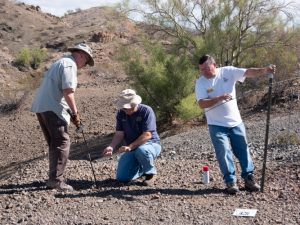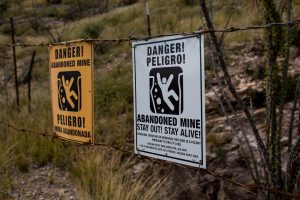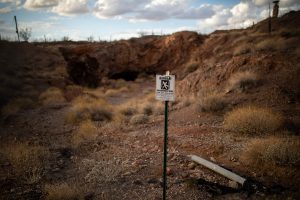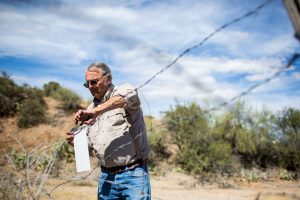- Slug: BC-CNS-Abandoned Mines. 2,895 words.
- 7 photos and captions below.
- Video here.
By CHRIS McCRORY
Cronkite News
PHOENIX – After he started hallucinating, John Waddell began to believe he would die. He had fallen 100 feet to the bottom of an abandoned gold mine in western Maricopa County, leaving him with a broken leg and rope-burned hands.
“It’s like a black cloud that’s a little stringy, and these figures were coming out of this little cloud: It almost looked like animals,” he recalled during an October news conference at Banner-University Medical Center in Phoenix. “They were going around and around inside the mine.
“That was kind of freaky. If I stayed down there, I knew I was going to die.”
Waddell, 60, survived three days in El Tigre mine, fighting off rattlesnakes and praying somebody would look for him. He had explored the mine, which is on his property near Aguila, for decades, hoping to find gold still glittering in the dark tunnels.
He’s among potentially thousands of people – often spurred by curiosity, greed or dumb luck – who seek out or stumble into Arizona’s vast store of mines abandoned by long-dead prospectors.
The state has an estimated 100,000 abandoned mines, according to the Arizona State Mine Inspector’s Office. However, officials have only identified about 19,000 of them, and they’ve secured even fewer. As more people move to and visit Arizona – many eager to explore the state’s more remote lands – the chances of coming across one of these hazardous mines only increases.
“We run into new mines every day,” said Laurie Swartzbaugh, deputy director of the Arizona State Mine Inspector’s Office.
The office only has two supervisors tasked with searching Arizona’s 9.3 million acres for these mines and securing them. They have legal authority to search all of it, public or private land. But these supervisors face the daunting task of trying to keep the public away from these mines, a challenge exacerbated by the fact the state doesn’t have a good handle on how many abandoned mines there really are.
Many experts believe Arizona has among the most abandoned mines in the country.
The mine inspector’s office has repeatedly requested more funding to help locate and secure these mines, but the Legislature has not granted a significant budget increase for its abandoned-mines program in a decade.
“We just don’t have enough people to get them all,” Swartzbaugh said.
State officials said it’s only a matter of time before more people die in these mines.
At least 35 people have died and 22 have been injured in abandoned mines in Arizona since 1969 – at least, that’s the best count from the mine inspector’s office. In fact, no state or federal agency has the exact number of deaths and injuries in Arizona because there’s no requirement that such accidents be reported.
The history: Mining goes unregulated for decades
Native Americans may have mined the land for turquoise, coal, clay and other minerals as early as 1000 BC, according to the State Mine Inspector’s Office. Spaniards began mining the land that would eventually become Arizona in the 1600s, according to the Arizona Mining Association, and over the next 400 years, the state’s rich bed of gold, silver, copper and other precious metals drew fortune seekers from around the world.
As the American West became more developed, larger mining operations opened, state mining officials said. Metal structures and mine carts began to dot the landscape, and abandoned mines became more common as prospectors left unsuccessful ventures for more profitable ones.
It wasn’t until the 1980s that Arizona began regulating hardrock mines more closely, mine experts in the state said. The state began to require mine operators to fill out hundreds of pages of paperwork and conduct environmental studies. Under current state law, prospectors must develop a plan for how to fill in any hole they open before they start digging.
But mines that were dug in the centuries before had no such regulation. That lack of oversight for hundreds of years led to sprawling underground complexes the state didn’t even know existed – much less had the capability to ensure a safe closure when the ore deposits ran out, state mining officials said.
Each mine site may have several entrances and exits, called adits, along with vertical shafts – some as deep as 900 feet – to help miners get air underground. Each of these tunnels is called a “feature,” and a mine complex can have dozens of them.
The sheer number of features can make it more difficult and time consuming for officials to identify and secure all a mine’s parts.
It’s often impossible to determine the depth or length of an abandoned mine from the surface.
“What you see would be the open shafts, the entrances to the mine,” said Eric Zielske, an environmental engineer at the federal Bureau of Land Management’s main office in Phoenix. “That may not, from the surface, look like it has that big of a footprint until you realize ‘OK, there’s another shaft over here, another shaft there.’”
The dangers: Hidden shafts to explosive materials
Abandoned mines often inspire treasure hunters, such as Waddell.
El Tigre mine, which began operating in 1939, is spread out over the 100 acres Waddell owns west of Phoenix.
“This particular shaft in my records indicated there was quite a bit of gold down inside, and I had explored everything else around the mine,” Waddell said, adding, “This is what I’ve been doing for 20 years. It gets in your blood.”
But people often underestimate the danger of entering and exploring these old mines. The dangers include collapsing boards and rocks, water-filled pits, dangerous animals, old explosives or hazardous chemicals and poor air quality, according to the U.S. Forest Service.
“They’re neat sites to go to, so sometimes you get people (who) like to camp out there,” Zielske said. “The risk there is people like to explore these open mine shafts or adits, and they don’t realize sometimes when you go walking into one of those areas, you can have limited oxygen.”
These mines are often in rugged, remote areas with limited cell phone service.
In Waddell’s case, his rigging snapped during his descent into the mine, and he had no way of contacting help. Without service, his cellphone was useless, so he had no choice but to wait until a friend came looking for him.
Waddell had told Terry Schrader where he was headed. Two days later, when Waddell still had not returned, Schrader set out.
“I thought I heard somebody pull up with a diesel truck. It was real quiet, and I started yelling and yelling ‘Help! Help!’” Waddell recalled at the hospital news conference in October.
“I started hearing someone hollering back, and I broke down and started crying because I knew that I’m going to get out of here.”
The U.S. Forest Service points out that people can run into bats, snakes, spiders, bobcats, mountain lions and other predators in these mines.
“Where I landed, I would have been face-to-face with this rattlesnake. Why it didn’t bite me or strike at me at first, I don’t know. But it didn’t,” Waddell said. “I pulled out the stick and started beating on this rattlesnake.”
Waddell killed the snake, the first of three during his three days underground.
But one wrong step on Waddell’s part could have led to disaster, as it has for many others.
In 1982, 15-year-old John Borrowdale died while exploring an abandoned mine in Arizona he found while hunting with a friend. In the darkness inside, he missed an 850-foot vertical shaft inside the main tunnel and fell to his death, according to records from the Arizona State Mine Inspector.
Dozens of people die or become injured in the U.S. every year while exploring or playing on both active and abandoned mine sites, according to the Mine Safety and Health Administration.
Roger Yensen, commander of the Maricopa County Sheriff’s Office’s volunteer Mountain Rescue Posse, said his unit alone rescues somebody from a mine shaft once every 12 to 16 months.
But – as with the number of abandoned mines – the state doesn’t have precise records for the number of accidents at these mines.
Until 2007, the mine inspector’s office tracked abandoned mine-related accidents by collecting newspaper clippings.
“I can’t guarantee what made the newspapers and what didn’t,” Swartzbaugh said. She said the office likely missed “some accidents or things that occurred that were not ever in the newspapers.”
For the past 11 years, the office has relied on law enforcement agencies to relay the information to them if a mine accident happens. But the state has no mandatory reporting policy, and what to report, if anything, falls to the individual agency responding to an incident.
Before Waddell’s accident, state records indicate the last abandoned mine shaft injury reported to the Arizona State Mine Inspector’s Office was in 2009.
But officials said growing population centers, including metro Phoenix and Tucson, are bringing more people in contact with previously hidden abandoned mines.
“You’re encroaching if we’re building out in those areas,” Swartzbaugh said. “Phoenix was not as large and as broken into as many cities in the 1800s. So, we’re encroaching on them.”
Even South Mountain Park, a hiking mecca for Phoenix and the largest municipal park in the country, has several easily accessible abandoned mines, including the well-trafficked Max Delta mine.
The solutions: Is money the only answer?
Several leaders from abandoned-mine programs in other states said the easiest way to improve safety is simple: provide the mine inspector’s office more money so it can hire more supervisors and pay for the materials to secure the mines.
Until that happens, the Arizona Mine Inspector’s Office must make do with the resources it has. Some civilian groups also have stepped in to help – although that’s not necessarily the solution state officials want.
Arizona’s abandoned mine program has a budget of just more than $194,000 per year, a drop in the bucket of the state’s $10.1 billion budget, which allocates the bulk of funding to education, health and correctional programs.
“That’s not very much money to operate a program,” said Autumn Coleman, president of the National Association of Abandoned Mine Lands Programs. “But it is better than nothing.”
The state, which could have the largest number of abandoned mines in the country, has not provided more money to the program – other than administrative adjustments, such as liability insurance – since the program was formally granted a budget in 2009. The inspector’s office has made yearly requests for more money, government budget documents show.
“We need more people out there to cover more ground because every time we go out (for) on- the-ground reconnaissance, we encounter more and more mines that are not in our database,” Swartzbaugh said.
Elise Kulik, an analyst for the governor’s Office of Strategic Planning and Budgeting, declined to comment on Gov. Doug Ducey’s budget priorities, deferring to a spokeswoman for the governor. That spokeswoman declined an interview with Cronkite News or to answer specific questions, but she sent a general statement about the governor’s budget priorities.
“We work closely with leaders, including the state mine inspector, to develop agency budgets with the goal of ensuring public health and safety of Arizonans,” the statement read.
Many other states fund their abandoned-mine programs through coal-mine taxes. But Arizona, California and Nevada produce little or no coal.
“If you don’t have any coal mines in your state, you don’t have any funding for the state mine inspector,” said Tom Gilleland, who owns Prescott-based Mine Gates Environmental, a company that designs and builds gates for abandoned mines and caves.
Arizona is the only one of the three low-coal Western states that does not have a dedicated revenue stream to its abandoned-mine program. California’s Department of Conservation revenue comes from gold mining, and Nevada’s program receives $10 for every mining claim submitted in the state. Nevada’s abandoned-mine program received more than $1 million in 2017, according to that state’s Division of Minerals.
In its inventory database, the Arizona State Mine Inspector’s office has the location of about 19,000 mine features, roughly the number that Nevada’s program has already closed.
Because so many abandoned mines have gone unidentified and unsecured in Arizona, some civilian groups have taken on the effort themselves.
For the past decade, the Havasu 4 Wheelers Club – a recreational group whose members bounce through the Mojave Desert in Jeeps – has prowled the dozens of trails near Lake Havasu City and fenced off about 180 abandoned-mine adits and shafts to keep other off-roaders safe, group representatives said.
“This is one of the first ones we did,” said Darryld Kautzmann, the fencing coordinator for the club, pointing to a barrier at the bottom of a rocky hill in the Mojave Desert during a trip in October to check on past work.
“We’ve fenced virtually every complex,” he said. “Now we’ve got isolated mines.”
Kautzmann, 78, checked the posts and examined the barbed wire of the fence, making sure erosion around the edges of the pit hadn’t loosened the barrier.
The group wants to ensure off-road vehicles don’t accidentally drive into an abandoned mine while cresting a hill or passing too close to an unseen hole.
Kautzmann said a member of the club came close to dying in one mineshaft 10 years ago. He drove his Jeep halfway into the shaft, which was at least 30 feet deep, on the edge of a popular trail. Other club members saved the driver by winching the back of his vehicle and dragging it out.
However, the Arizona State Mine Inspector’s Office discourages groups such as the Havasu 4 Wheelers Club from trying to secure mine features. Officials worry about the risk of well-meaning fencers falling to their death.
“We do not encourage someone to go out to these abandoned mines to post or fence or to look for them,” Swartzbaugh said. “If you step on them, you fall – and either a short distance, which might be 30 feet, or you fall a lot further than that and you don’t survive it.”
“The Green Valley News” reported in 2017 about a group called the Hazardous Abandoned Mine Finders, which had been doing similar civilian fencing work across Pima, Santa Cruz and Cochise counties since 1989.
The group reportedly put up warning signs and fence posts around 10,000 abandoned-mine features, but it shut down when the U.S. Forest Service pulled support from the group, citing staff members’ concerns about safety.
Havasu 4 Wheelers Club members downplayed the threat.
“We’ve got people with a variety of backgrounds to work in hazardous situations,” said Jim Bowen, a former president of the Havasu 4 Wheelers Club. He said many of the group’s 450 members are retired firefighters, police officers and EMTs. “We go out as a group, and we’ve become very efficient at doing it.”
Groups such as the Havasu 4 Wheelers Club are rare because groups that interact with abandoned mines could be liable for any future deaths or injuries, especially if any environmental problems occur, according to current federal law.
“We don’t really see too much of what we would call the Good Samaritans going out building these fences,” said Robert Ghiglieri, chief of Nevada’s Abandoned Mine Lands program. “There are large companies that would be willing to do some Good Samaritan work, but they understand, especially with environmental, once they touch it, they own it, and nobody wants to bring that liability onto themselves.”
The fences aren’t foolproof
Fencing is the most common and inexpensive method to secure abandoned mines, but it’s also one of the least effective, according to mine safety experts, because it can highlight the mine’s existence to curious explorers, who merely have to cut wire, duck under a fence or kick down a post to subvert the barrier.
Installing metal gates over shafts and adits are more effective at stopping people, but they’re also more expensive.
Gilleland, whose company bids on government contracts for such projects, said the shop does fewer jobs in Arizona than in neighboring Nevada and New Mexico.
“They have no funding,” Gilleland said of Arizona. While Gilleland declined to give a price range for his services, officials from the Arizona State Mine Inspector’s Office say each gate can run in the thousands of dollars. In comparison, a fence usually costs less than $100.
Partnerships and other solutions may help lower the danger for Arizona’s high number of abandoned mines, but the only true solution is spending more money, said Coleman, with the National Association of Abandoned Mine Lands Programs.
“That’s pretty much what it comes down to,” she said.
In the meantime, Swartzbaugh submitted the office’s next budget proposal to Ducey on Aug. 30. The proposal includes a $347,000 request to hire three additional people for the abandoned-mines program, including supervisors. Mine Inspector Joe Hart, who declined multiple interview requests by Cronkite News, has written the same letter to accompany that request every year since his election in 2006.
“We can only anticipate that additional deaths and injuries will occur under the existing conditions,” Hart wrote. “It is not a matter of ‘if,’ it is a matter of when another death or injury will occur.”
– Video by Bryce Newberry/Cronkite News
This story is part of Elemental: Covering Sustainability, a multimedia collaboration between Cronkite News, Arizona PBS, KJZZ, KPCC, Rocky Mountain PBS and PBS SoCal.
Coming tomorrow
Meet Jerry Tyra, one of only two abandoned-mine supervisors in Arizona. The pair face an uphill battle trying to identify the estimated 100,000 abandoned mines in the state and render them safe, or at least safer.
For more stories from Cronkite News, visit cronkitenews.azpbs.org.
^_=
